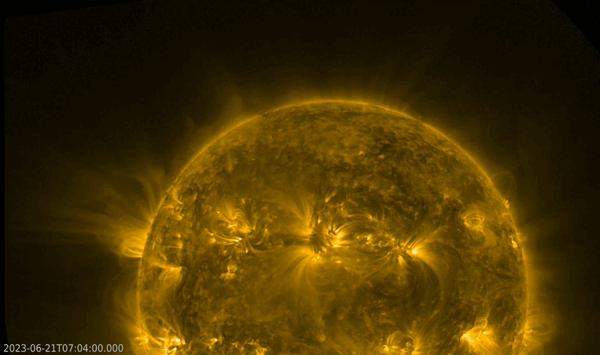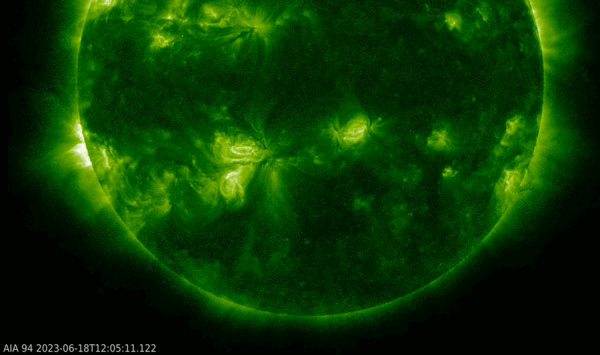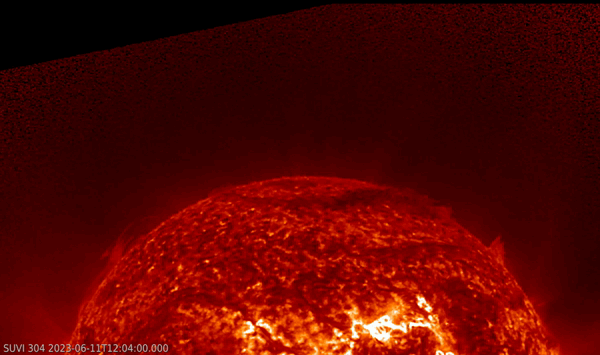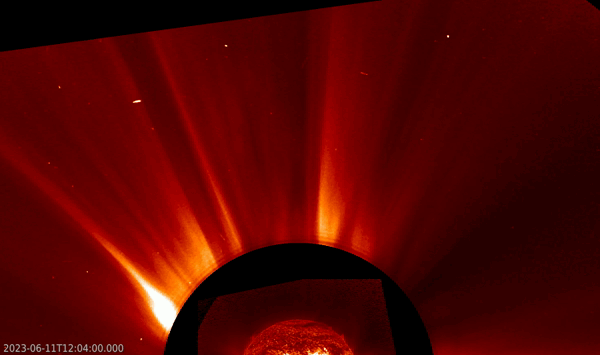Over the last few weeks, sunspot activity has been high with the daily estimated international sunspot number (EISN ; SILSO) above 200 from 20 till 24 June. Despite the numerous sunspot groups present on the solar disk, the resulting number of strong flares was rather meager with only about a dozen of low-level M-class flares and a single X-class event. The latter occurred on 20 June and took the space weather forecasters by surprize, as discussed in this STCE newsflash.
Nonetheless, a few stunning solar eruptions have taken place that are worthwhile mentioning here. A remarkable event took place on the farside of the Sun on 21 June. The source was still a full day behind the Sun's northeast limb, when around 09:00UTC a large and dense filament could be seen flinging into space. About 2 hours later, post-eruption coronal loops could be seen rising above the solar limb. Still visible a day later, they towered about 125.000 km above the limb, that's about a third of the Earth-Moon distance. When the presumed source region turned over the solar limb, it consisted -in white light- of a bright faculae field with only a few small sunspots. Interestingly, vigourous sunspot development has been observed starting on 26 June, and this new region (NOAA 13354) is now being watched as a potential source of strong flares. The extreme ultraviolet (EUV) imagery underneath are from the SUVI instrument onboard GOES-18, showing the ejected filament and the rising coronal loops at a temperature of about 700.000 degrees (SUVI 171).

Just a few days earlier, on 18 June, an M2.5 flare took place in the southern solar hemisphere. Assigned to active region NOAA 13336, it resulted most likely from the magnetic interaction between two sunspot regions quite close to each other: the more southern and sunspot-poor group NOAA 13336, and the larger, more complex active region NOAA 13335 just 5 degrees towards the solar equator. Also a small filament to the southeast ("lower left") of NOAA 13336 was involved. The complex interactions resulted in a spectacular outlook of the flare in EUV as shown in the SDO/AIA 094 at very high temperatures of several million degrees. The combination with the SDO/HMI white light imagery to the right shows the location of the relevant sunspot groups (annotated). The associated coronal mass ejection (CME) was narrow and not directed to Earth.


Solar filaments are clouds of charged particles ("plasma") above the solar surface squeezed between magnetic regions of opposite polarity. Being cooler and denser than the plasma underneath and their surroundings, they appear as dark lines when seen on the solar disk. Polar crown filaments (PCF) are located at the highest latitudes, separating the predominant polar field of the previous cycle and the dispersed field of the current cycle, which is drifting poleward from the trailing polarities of sunspot groups at lower latitudes. The "old" polar magnetic field is currently still strong enough to keep the newly arriving opposite polarity field at bay, and where the two encounter each other, a solid filament can form. This also means that small changes in these magnetic fields may result in instabilities in and the subsequent eruption of (a portion of) the filament. Just such an event was recently described in this STCE newsitem reporting on eruptive activity in the northern PCF early February this year.
The PCF eruption early on 12 June was much more spectacular. The contrast-enhanced SUVI 304 images underneath first show a gradual rising of the filament late on 11 June followed by a sudden and impressive eruption a few hours later. Because of SUVI's wide field of view, the gap between its images (in EUV) and SOHO's coronagraphic images (white light!) is relatively small. The combination of the two allows a fine tracking from the filament eruption to the core of the associated CME, courtesy also of the huge size of the eruption. According to CACTus, the CME had a speed near 500 km/s and was obviously not directed to Earth.







